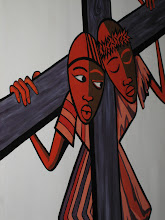
Within Christianity there are many symbols and rituals that hold great importance for believers and the faith community. Many times these rituals and symbols speak great volumes to people based on the situations they face in life, as well as the cultural context in which people live. Saints, those who have lived an extraordinary life by following Christ to the highest degree, have been particularly meaningful to Catholics who often have searched for another way to connect and grow in their relationship with God. For women in the Twentieth Century, St. Jude played an extremely significant role in their lives, as their relationship grew, as did their communion, love and devotion to the saint of hopeless causes. During that time period women were required to take on harsh gender roles and a societal script for how to live their lives, which were forced upon them by mainstream American culture. As a result, woman turned to St. Jude, the patron saint of hopeless causes, in order to resist and cope with the problems in their lives as they worked to regain religious power, a supportive and female-centered community, and a voice.
Unfortunately, society has fabricated things such as “particular arrangements of gender, class, [and] race,” which are often “treated as natural or given, part of the taken-for-grantedness of the world even though they are made and sustained in culture.” (Orsi 211) Women in the Twentieth Century fell into this trap, which told them they had a specific role in society. In his text, Thank You St. Jude: Women’s Devotion to the Patron Saint of Hopeless Causes, Robert A. Orsi explained that married women during the time period of the Twentieth Century were expected to stay at home, care for the children, be silent sufferers, and martyrs. The man’s role in society was to be the “bread winner” or sole financial supporter of the family, in other words the stable and courageous one. The script that was given to women was certainly put to the test during the troublesome years of the Great Depression. The Great Depression challenged women in an extreme manner, placing new stresses and problems in their lives. Interestingly enough, women were the ones who had to go out and work to support the family, much to the disdain of men. The “natural bread winners”—men, were no longer able to feed their families because they were being laid off from their blue color jobs. The only stable jobs were white collar occupations, which were at the time being held by women. Not only did women hear constant complaining by men who were jealous and humiliated by the fact that they were no longer the reliable one’s in the family, but women who were out of place also had to deal with the problems that arose from their husbands’ uneasiness. Many times women had to face the reality that their husbands were drinking away their families’ fortunes or even in extreme cases when men left them for good. Overall, the Depression began undermining the Catholic role of family. Women needed something to turn to where they could find answers; this we will see was St. Jude.
Another time in the Twentieth Century when women were out of place was during WWII. Women had to work because their husbands were off at war and their families could not survive if they did not maintain at least one job. Not only was work strenuous on women, but they were expected to hold their husbands as the center of their lives. They were also expected to be brave when their husbands were sent away to be killed overseas. These pressures continued to build and were problems that women had to deal with in one way or another.
Lastly, the Post WWII era brought about another difficulty for women, this being child rearing. Women were now being called to give birth in hospitals, a new and strange environment. They no longer had the support of their family when delivering a child and were robbed of the religious meaning of pain during the process of giving birth because new drugs/pain killers were being used. The sacred and natural aspect of having children was destroyed, and consequently childbirth became meaningless. The overlying problem at hand was that women once had a place in society as mother and wife. Even if this script was written for them or role forced upon them in the past, they used to have a place in society. However, when the Twentieth Century came along women became out of place in the realm of the American Catholic culture, they needed something to lean on, and this essentially becoming devotions to St. Jude.
Society called for women to rely on men during the Twentieth Century, men who were not dependable for the reasons previously explained. One vital point of emphasis was the fact that during this period and course of events women had no voice. Women were not allowed to speak about the problems that occurred within their home, especially the problems that their husbands had caused. Women were continuously forced to respect society’s manufactured role for them; that they were to be silent sufferers and martyrs. Certainly, women knew that if they did speak of their concerns/problems things would have only worsened. However, women also realized that they could not keep their problems to themselves because if they did their lives would not improve. As a result, devotions to St. Jude allowed women to voice their problems, concerns, and troubles to other women who were in a similar or the same situation as they were. St. Jude provided women with a warm and welcoming figure who was always willing to listen, as well as able to offer an environment that was safe and confidential for women to speak up about their disoriented lives. The prayers women made to St. Jude were “situated precisely at the point where the personal, intimate experience intersected with the greater impersonal forces of history under way outside the door.” (Orsi 49) St. Jude was the ideal man according to many women because he cared, he listened, and he gave women a voice, things that the men in their lives deprived women of.
St. Jude also helped women take a stand and not simply accept the manipulating forces in their lives. Although women were extremely involved with St. Jude, they also realized that there was a difference between themselves and their saint. Women were the one’s who had to face the reality of the world, the ways society was oppressing them, and how they had to be proactive and do something about the situation they were forced to live in. St. Jude was the provider of hope and women did enter into a unique relationship with the saint. Nevertheless, Jude was distinct from the women themselves. Devotion to St. Jude granted women solidarity and a supportive female-centered community. In the past women had been isolated, cut off from their families, as well as the male dominated society. However, by means of devotions to St. Jude, a supporting cast and community of others with a similar identity, was what women needed and received in order to help them create a new script for themselves in society.
Finally, devotions to St. Jude gave women a great sense of hope and more religious power. Narratives of petition, where “asking” occurred, allowed women to have a connection and/or network of women who introduced other women to St. Jude. This was very important because new members of Jude’s devout community brought strength and life to those already in St. Jude’s “fold.” As the numbers of devotees to the saint increased so did their power. Narratives of grace also took place during devotions to Jude, these being stories of times of miraculous intercession by the saint in the lives of women. Therefore, St. Jude was creating new perspectives for women and granting them the hope they so desperately needed. The saint provided women with a “courageous response to life’s troubles undertaken with love and trust.” (Orsi 208) As a result of devotions to St. Jude, women were able to legitimately challenge the script that society had forced upon them, essentially the war of words. According to Orsi, language (scripts) shape people and the culture in which they live. A script tells the people of a particular culture “XYZ,” however these are merely limiting factors that should not be automatically accepted, but examined carefully. Jude was a “supple, multidimensional [idiom] for working on the self and the world in an oscillating dialectic ‘fantasy’ and ‘reality,’ self and other, objective and subjective, past and present, submission and resistance.” (Orsi 210) Consequently, St. Jude was a resource for women to view their lives in a different manner, other than the societal script and role that had already been written for women by the mainstream American culture. Eventually, women gained more religious power and authority in the Church as they continued to fight for their rights and their voices were granted back to them.
In conclusion, St. Jude was the “X-Factor” for women. Jude was the force that spared women from possibly being confined to the societal script/role within the American Culture for the long term. Without their devotions to St. Jude, women might have been oppressed for the remainder of the Twentieth Century and beyond. What is certain, is that the patron saint of hopeless causes allowed women to triumph in due time over the struggles that came about during the times of the Depression, WWII, and the Post WWII era when women were out of place. St. Jude allowed women to gain more religious power, achieve a supportive and female-centered community, and granted them a voice. This voice and new place in society which St. Jude helped women attain by means of a new script, established major historical changes resulting from future events such as the successful women’s movement.


































No comments:
Post a Comment